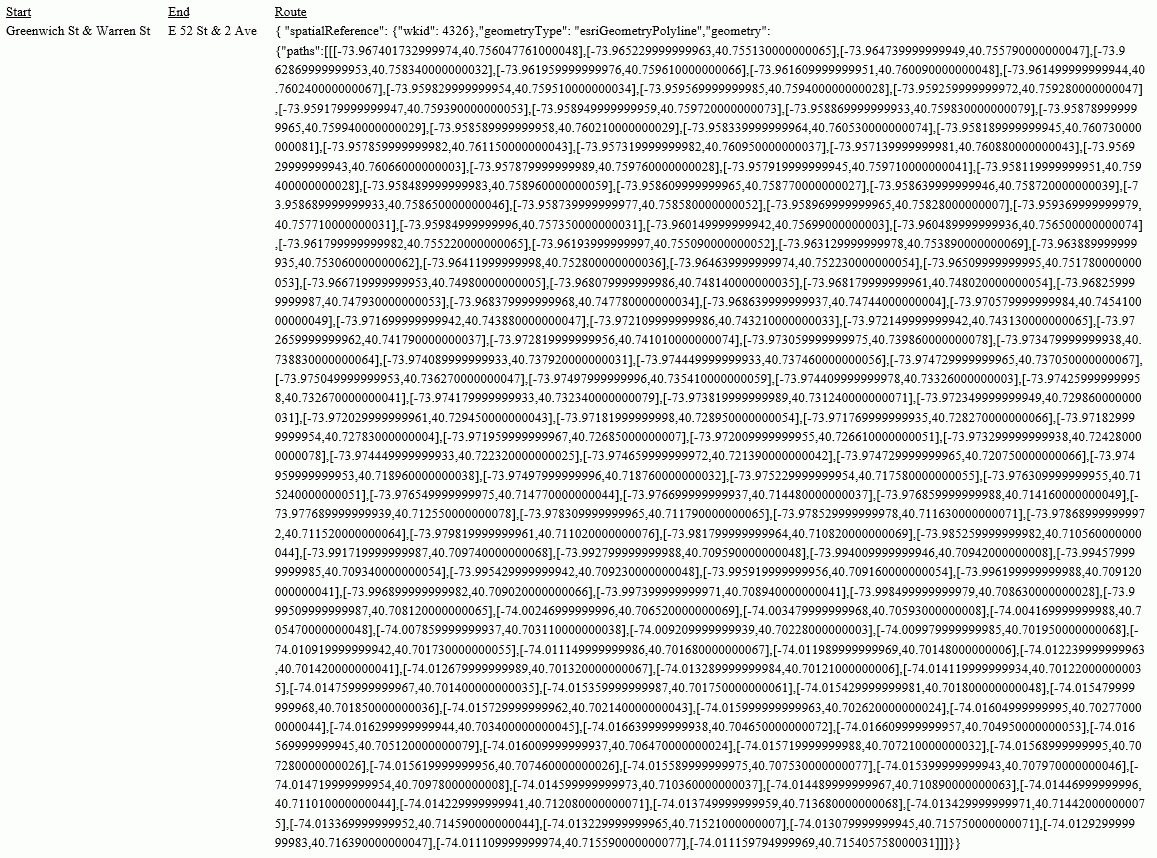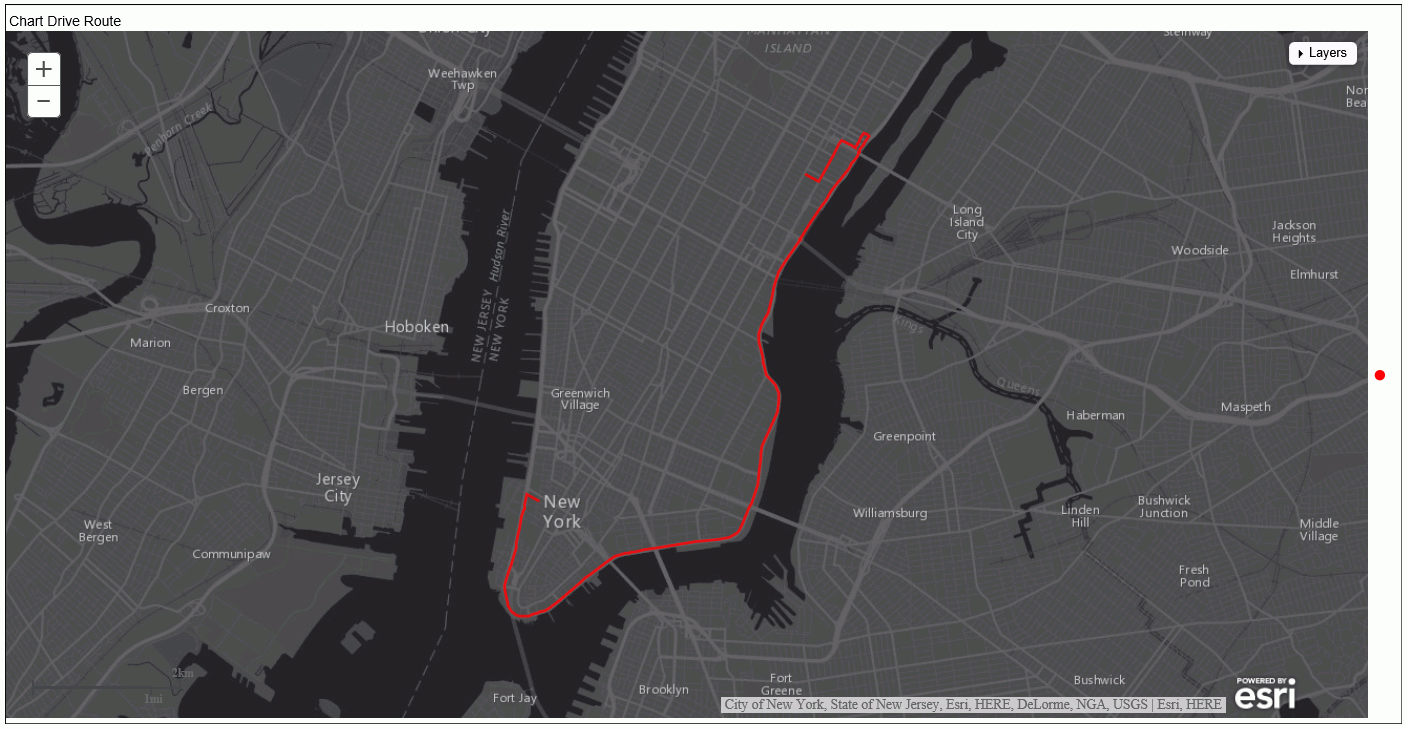Syntax: How to Calculate the Drive Route Between Geometry Points
GIS_DRIVE_ROUTE(geo_start_point,geo_end_point)
where:
- geo_start_point,geo_point2
-
Fixed length alphanumeric, large enough to hold the JSON describing the point (for example, A200).
Is the starting point for which you want to calculate the drive route.
Note: You can generate a geometry point using the GIS_POINT function.
- geo_end_point,geo_point2
-
Fixed length alphanumeric, large enough to hold the JSON describing the point (for example, A200).
Is the ending point for which you want to calculate the drive route.
Note: You can generate a geometry point using the GIS_POINT function.
The format of the field to which the drive route will be returned is TX.
Example: Calculating the Drive Route Between Two Geometry Points
The following uses a citibike .csv file that contains station names, latitudes and longitudes, and trip start times and end times. It uses the GIS_POINT function to define geometry points for start stations and end stations. It then uses GIS_DRIVE_ROUTE to calculate the route to get from the end point to the start point.
DEFINE FILE esri/esri-citibike
STARTPOINT/A200 = GIS_POINT('4326', START_STATION_LONGITUDE, START_STATION_LATITUDE);
ENDPOINT/A200 = GIS_POINT('4326', END_STATION_LONGITUDE, END_STATION_LATITUDE);
Route/TX140 (GEOGRAPHIC_ROLE=GEOMETRY_LINE) =
GIS_DRIVE_ROUTE(ENDPOINT, STARTPOINT);
END
TABLE FILE esri/esri-citibike
PRINT START_STATION_NAME AS Start END_STATION_NAME AS End Route
WHERE START_STATION_ID EQ 147
ON TABLE SET PAGE NOLEAD
ON TABLE SET STYLE *
TYPE=REPORT, GRID=OFF,SIZE-11,$
ENDSTYLE
ENDThe output is shown in the following image.

Example: Charting a Driving Route Between Two Geometry Points
The following request uses GIS_DRIVE_ROUTE to generate a driving route between a station start point and end point and charts the route on an Esri map.
DEFINE FILE esri-citibike
STARTPOINT/A200 = GIS_POINT('4326', START_STATION_LONGITUDE, START_STATION_LATITUDE);
ENDPOINT/A200 = GIS_POINT('4326', END_STATION_LONGITUDE, END_STATION_LATITUDE);
Route/TX80 (GEOGRAPHIC_ROLE=GEOMETRY_LINE) =
GIS_DRIVE_ROUTE(ENDPOINT, STARTPOINT);
ENDGRAPH FILE ESRI-CITIBIKE PRINT START_STATION_NAME END_STATION_NAME WHERE START_STATION_ID EQ 147 ON TABLE PCHOLD FORMAT JSCHART ON TABLE SET LOOKGRAPH CHOROPLETH ON TABLE SET EMBEDHEADING ON ON TABLE SET AUTOFIT ON ON TABLE SET STYLE * TYPE=REPORT, TITLETEXT='Map', PAGESIZE=E, CHART-LOOK=com.esri.map, $ TYPE=DATA, COLUMN=N1, /*START_STATION_NAME*/ BUCKET=tooltip, $ TYPE=DATA, COLUMN=N2, /*END_STATION_NAME*/
*GRAPH_JS_FINAL
"legend": {"visible": true},
"extensions" : { "com.esri.map" :
{ "scalebar" :
{
"scalebarUnit": "dual",
"attachTo" : "bottom-left"
},
"baseMapInfo": {
"drawBasemapControl" : false,
"showArcGISBasemaps" : false,
"customBaseMaps" : [
{"ibiBaseLayer" : "dark-gray"}
]
},
"overlayLayers":
[{
"ibiDataLayer": {"map-geometry" : {"map_by_field" : "Route"}}, "title" : "Chart"}]
},
"introAnimation": "{\"enabled\":false}"
}
*END
ENDSTYLE
HEADING
"Chart Drive Route"
END The output is shown in the following image.
